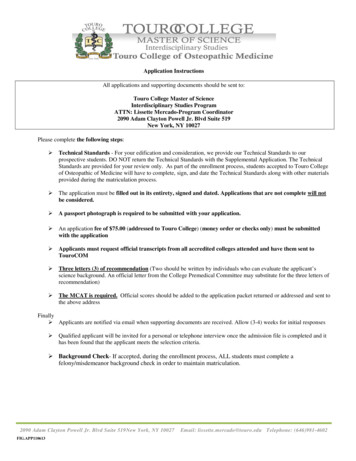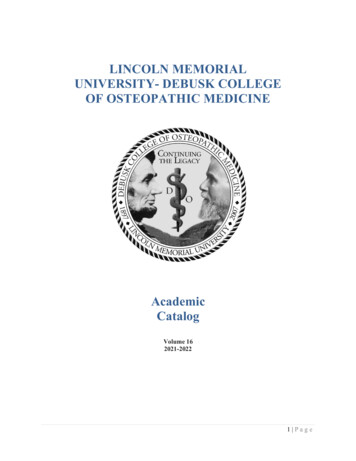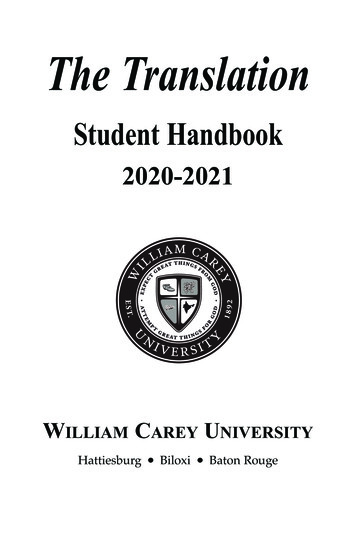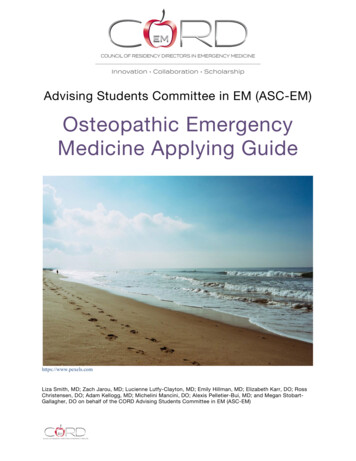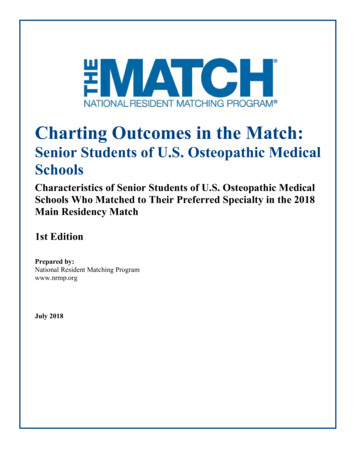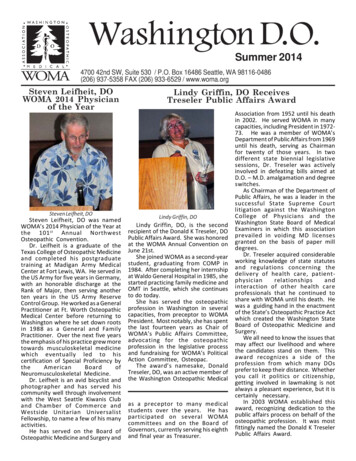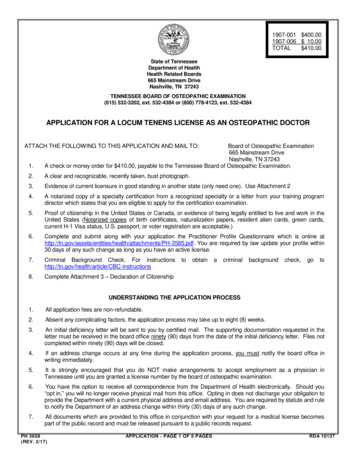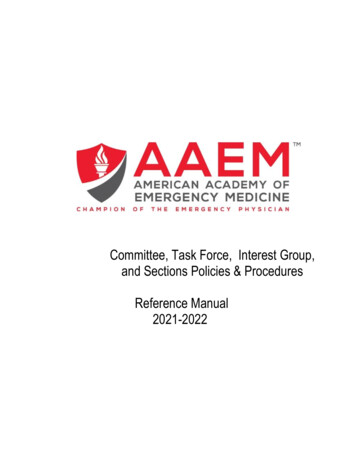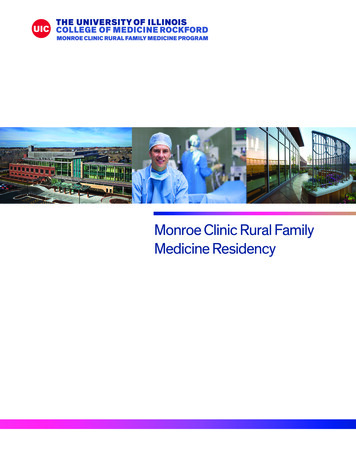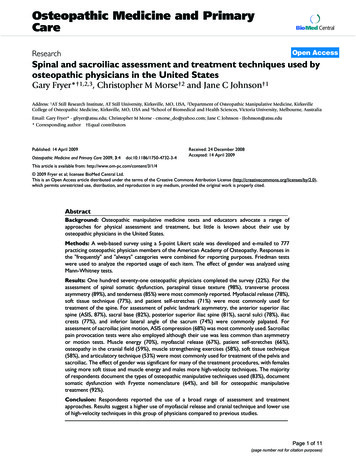
Transcription
Osteopathic Medicine and PrimaryCareBioMed CentralOpen AccessResearchSpinal and sacroiliac assessment and treatment techniques used byosteopathic physicians in the United StatesGary Fryer*†1,2,3, Christopher M Morse†2 and Jane C Johnson†1Address: 1AT Still Research Institute, AT Still University, Kirksville, MO, USA, 2Department of Osteopathic Manipulative Medicine, KirksvilleCollege of Osteopathic Medicine, Kirksville, MO, USA and 3School of Biomedical and Health Sciences, Victoria University, Melbourne, AustraliaEmail: Gary Fryer* - gfryer@atsu.edu; Christopher M Morse - cmorse do@yahoo.com; Jane C Johnson - JJohnson@atsu.edu* Corresponding author †Equal contributorsPublished: 14 April 2009Osteopathic Medicine and Primary Care 2009, 3:4doi:10.1186/1750-4732-3-4Received: 24 December 2008Accepted: 14 April 2009This article is available from: http://www.om-pc.com/content/3/1/4 2009 Fryer et al; licensee BioMed Central Ltd.This is an Open Access article distributed under the terms of the Creative Commons Attribution License (http://creativecommons.org/licenses/by/2.0),which permits unrestricted use, distribution, and reproduction in any medium, provided the original work is properly cited.AbstractBackground: Osteopathic manipulative medicine texts and educators advocate a range ofapproaches for physical assessment and treatment, but little is known about their use byosteopathic physicians in the United States.Methods: A web-based survey using a 5-point Likert scale was developed and e-mailed to 777practicing osteopathic physician members of the American Academy of Osteopathy. Responses inthe "frequently" and "always" categories were combined for reporting purposes. Friedman testswere used to analyze the reported usage of each item. The effect of gender was analyzed usingMann-Whitney tests.Results: One hundred seventy-one osteopathic physicians completed the survey (22%). For theassessment of spinal somatic dysfunction, paraspinal tissue texture (98%), transverse processasymmetry (89%), and tenderness (85%) were most commonly reported. Myofascial release (78%),soft tissue technique (77%), and patient self-stretches (71%) were most commonly used fortreatment of the spine. For assessment of pelvic landmark asymmetry, the anterior superior iliacspine (ASIS, 87%), sacral base (82%), posterior superior iliac spine (81%), sacral sulci (78%), iliaccrests (77%), and inferior lateral angle of the sacrum (74%) were commonly palpated. Forassessment of sacroiliac joint motion, ASIS compression (68%) was most commonly used. Sacroiliacpain provocation tests were also employed although their use was less common than asymmetryor motion tests. Muscle energy (70%), myofascial release (67%), patient self-stretches (66%),osteopathy in the cranial field (59%), muscle strengthening exercises (58%), soft tissue technique(58%), and articulatory technique (53%) were most commonly used for treatment of the pelvis andsacroiliac. The effect of gender was significant for many of the treatment procedures, with femalesusing more soft tissue and muscle energy and males more high-velocity techniques. The majorityof respondents document the types of osteopathic manipulative techniques used (83%), documentsomatic dysfunction with Fryette nomenclature (64%), and bill for osteopathic manipulativetreatment (92%).Conclusion: Respondents reported the use of a broad range of assessment and treatmentapproaches. Results suggest a higher use of myofascial release and cranial technique and lower useof high-velocity techniques in this group of physicians compared to previous studies.Page 1 of 11(page number not for citation purposes)
Osteopathic Medicine and Primary Care 2009, 3:4BackgroundOsteopathic practice typically involves a holistic, multidimensional approach to patient care and may include ental, ergonomic, and biomechanical issues.Physical examination of patients may commonly be performed in relation to the osteopathic concept of somaticdysfunction. Somatic dysfunction has been described as afunctional disturbance to tissues of the musculoskeletalsystem and related vascular and neurological components, amenable to osteopathic manipulation [1].Authors in the field of osteopathic manipulative medicine(OMM) have proposed a wide range of methods andapproaches for the assessment and treatment of spinaland pelvic somatic dysfunction. There are at least 28 osteopathic techniques listed in the Glossary of Osteopathic Terminology [2] which, despite their overlap, can be groupedinto direct, indirect, and combined techniques. These areall typically used within the context of the various conceptual models for osteopathic manipulative treatment(OMT), including the postural/biomechanical, neurological and respiratory/circulatory models [1,3-7]. In contrastto authors outside the United States (US) [8-10], manyAmerican authors of osteopathic texts [1,5,6,11] basestructural assessment and treatment of the spine on thebiomechanical model proposed by Fryette [12] and basepelvic approaches on the biomechanical model proposedby Mitchell [13]. Little is known, however, about theOMM preferences of osteopathic physicians regardingassessment and treatment approaches or documentationand billing practices. Few studies have been conducted todetermine which approaches are commonly used inOMM practice, either in the US or elsewhere, and it istherefore difficult to compare the practice of OMMthroughout the world.Johnson and Kurtz [14] surveyed primary care osteopathicphysicians who were members of the American Osteopathic Association for preferences regarding OMT selection from a list of techniques in Foundations for OsteopathicMedicine [7]. Respondents were more likely to use directtechniques, such as soft tissue, high-velocity low-amplitude thrust (HVLA), and muscle energy, than indirecttechniques. Female physicians and older respondents,however, were more likely to use indirect approaches thanyounger male respondents. OMT specialists were morelikely to use a broader range of techniques, including cranial and fascial ligamentous release techniques. This studydid not survey physicians about their preferences regarding diagnostic methods.Few studies have examined OMT preferences in othercountries. In 2004, the Australian Osteopathic Association conducted a member-wide census, which included ahttp://www.om-pc.com/content/3/1/4survey with a snapshot component [15,16]. Osteopathsestimated that they more frequently used direct techniques [16], and this opinion was supported by the snapshot survey of actual usage that indicated the mostfrequently used techniques were soft tissue (71% ofpatients), articulation (57%), HVLA (51%), and muscleenergy (50%) [15]. The census did not examine diagnosticmethods. Peace and Fryer surveyed the Australian profession for pelvic and sacroiliac diagnostic approaches andfound that most respondents used procedures consistentwith the Mitchell model, such as flexion tests and identification of pelvic landmark asymmetry, but supportedthese tests with additional motion and pain provocationtests [17].In the United Kingdom (UK), the General OsteopathicCouncil conducted a snapshot survey to update information about the practice of osteopathy obtained from previous snapshots [18]. The survey requested informationabout patients and practitioners, including the treatmenttechniques employed on the snapshot day. Results weresimilar to the surveys conducted in the US and Australia:osteopaths most frequently used direct techniques, particularly soft tissue stretching (78% of patients), articulation(75%), HVLA (47%), and muscle energy (26%).Despite the variety of OMM approaches advocated, onlyone study [14] has surveyed the American osteopathicprofession regarding the use of different OMM techniquesand none has investigated the diagnostic methods currently in use. Through the use of a web-based survey, thepresent study investigated methods used for the assessment and treatment of spinal and pelvic somatic dysfunction by osteopathic physicians. Additionally, thedocumentation and billing of OMT services by osteopathic physicians were investigated. Given that the usageof OMT within the American profession is reportedly low[19,20], practicing physician members of the AmericanAcademy of Osteopathy (AAO), an association whichemphasizes the integration of osteopathic principles andmanipulative treatment in patient care, were targeted forthis study.MethodsThe subjects of this study were practicing AAO physicianmembers. Members who were students, interns, residents,or international affiliates were excluded from the surveydistribution list to ensure that only practicing AAO physicians responded.A web-based survey with a 5-point Likert scale was developed for the study. The survey contained questions pertaining to respondent demographics, procedures used toidentify spinal somatic dysfunction, knowledge and use ofspinal biomedical models, use of diagnostic imagingPage 2 of 11(page number not for citation purposes)
Osteopathic Medicine and Primary Care 2009, 3:4before OMT, techniques used to treat spinal somatic dysfunction, procedures used to identify pelvic and sacroiliacsomatic dysfunction, techniques used to treat pelvic andsacroiliac somatic dysfunction, and documentation ofand billing practices for somatic dysfunction and OMT(see Additional file 1). Open-ended "Other" responseswere included in the survey for those procedures not listedas a choice.Prior to dissemination of this survey, a draft survey waspiloted on five practicing osteopathic physicians andthree OMM residents. Based on their suggestions, the survey was slightly modified. Of the 1625 eligible AAO members, 777 (48%) had listed e-mail addresses, and aninvitation to participate with a web link to the survey wase-mailed to these members. Two weeks after this initialmailing, a reminder e-mail was sent. The local institutional review board approved the study.The available response categories (strongly disagree, disagree, etc.) are ordinal and were converted into numericallyweighted scales. For reporting purposes, the combinedpercentage of responses in the "Frequently" and "Always"categories were combined. Open-ended responses in the"Other" category were examined and redundant or inappropriate responses (such as methods for global structuralassessment rather than the requested segmentalapproaches) were excluded. Friedman tests were used todetermine if significant differences existed between thereported usage of each item. The effect of gender and yearsof practice (categorized by decade) on preference ofassessment and treatment techniques were analyzed usingMann-Whitney tests.ResultsParticipantsOne hundred seventy-two osteopathic physiciansresponded to the survey, a 22% response rate. Onerespondent was excluded for reporting no use of OMT.Sixty-nine percent of the respondents were male, had amean of 15 years experience (SD 11, range 0–53), andwere educated at a variety of schools. The most commontraining institutions were Kirksville College of Osteopathic Medicine (KCOM), New York College of Osteopathic Medicine (NYCOM) and University of NewEngland College of Osteopathic Medicine (UNECOM);each comprised 11% of respondents, with the remaining67% of respondents having trained at 17 other osteopathic colleges.Respondents indicated that they used OMT: 59% estimated they used OMT on 76–100% of patients, 13% on51–75%, 14% on 26–50%, and 15% on 1–25%. Listedspecialties or designations were OMM/Neuromusculoskeletal Medicine (60%), Family Practice/OMT (51%),http://www.om-pc.com/content/3/1/4Fellow of AAO (12%), Sports Medicine (6%), PhysicalMedicine and Rehabilitation (5%), Medical Acupuncture(2%), Emergency Medicine (2%), and Other (13%).Assessment of spinal dysfunctionOsteopathic physicians reported the most common use ofprocedures associated with the structural approach(between 69% and 98%), including palpation of paraspinal tissue texture (98%), transverse process asymmetry(89%), and tenderness (85%) [P .0001, (Figure 1)]. Theassessment of motion of transverse processes (80%), spinal processes asymmetry (70%), springing of vertebrae(69%), motion of sidebending (69%), and use of osteopathy in the cranial field (OCF, 68%) was also commonlyreported. The skin rolling test (6%) and percussion (9%)were least commonly used. Nineteen responses wereincluded in the "Other" category, the most frequent beingJones points/counterstrain, lateral translatory or oscillatory maneuvers, and energetic based procedures.There were no significant differences between males andfemales on the procedures used. Osteopathic physiciansin practice for 10–19 years were more likely to use springing of vertebrae than 0–9 years and 20 years (P .02,79% vs. 67% and 65%, respectively).Most respondents had knowledge of the Fryette spinalbiomechanical model (89%). Sixty percent reported thatthe model was frequently/always useful for diagnosis andtreatment although 21% indicated they commonly diagnosed motion restriction combinations that contradictedthe model. The use of radiology and diagnostic imagingwas low, with only 7% of respondents frequently/alwaysusing imaging prior to delivering cervical OMT and with3% using imaging prior to delivering OMT to otherregions of the spine.Treatment of spinal dysfunctionProcedures for the treatment of somatic dysfunction of thespine reported to be most commonly used were myofascial release (direct or indirect, 78%), soft tissue technique(77%), patient self-stretches (71%), and OCF (65%) (Figure 2). Forty-six responses for spinal treatment techniqueswere volunteered under "Other" and included the use ofthe percussion hammer, visceral technique, acupuncture,and prolotherapy.There was a significant effect of gender for many of theprocedures. Female respondents reported more commonuse of soft tissue technique (P .003, 91% of females vs.71% of males), muscle energy technique (P .03, 79% vs.60%), and patient strengthening exercises (P .04, 81%vs. 67%). Male respondents reported more common useof direct HVLA (P .01 58% of males vs. 34% of females).Osteopathic physicians in practice for 0–9 years werePage 3 of 11(page number not for citation purposes)
Osteopathic Medicine and Primary Care 2009, 3:4http://www.om-pc.com/content/3/1/4Paraspinal Tissue TextureTransverse Process AsymmetryPalpation for TendernessMotion of Transverse ProcessesSpinous Process AsymmetrySpringing of VertebraeMotion of SidebendingCranial Approach (OCF)Motion Using Long LeverageSegmental TemperatureSegmental Moisture ChangesRed ReflexEase or Bind ResponsesSkin Rolling rcent of RespondentsSometimesRarelyNeverFigure 1 used to identify spinal somatic dysfunctionProceduresProcedures used to identify spinal somatic dysfunction.more likely to use the Still technique than 10–19 yearsand 20 years (P .02, 34% vs. 20% and 28%, respectively).but volunteered under "Other" included Patrick's FABER,Gaenslen, and Trendelenburg tests, as well as many otherprocedures only reported in single instances.Assessment of pelvic and sacroiliac dysfunctionBetween 39% and 87% of respondents estimated that theyfrequently/always assessed various pelvic landmarks forbony asymmetry. The most common landmarks assessedwere the anterior superior iliac spine (ASIS [87%]), sacralbase (82%), posterior superior iliac spine (PSIS [81%]),sacral sulci (78%), iliac crests (77%), and inferior lateralangle of the sacrum (74%) [P .0001, (Figure 3)]. Twentyresponses listed under "Other" included assessment of L5,pelvic and lumbar musculature, and iliolumbar ligaments.The most commonly used SIJ pain provocation tests werethe active straight leg raise (52%) and ASIS compression(48%), but these tests were less employed than many ofthe landmark and motion tests [P .0001, (Figure 4)]. Infact, five respondents volunteered that they deliberatelydo not use pain provocation tests. Eighteen responses forprovocation tests not listed in the survey but volunteeredunder "Other" included Patrick's FABER test and deeppressure on the sacral sulci.Sacroiliac joint (SIJ) motion tests were also commonlyused. The most common motion test was ASIS compression (68%), followed by OCF (61%), the standing flexiontest (54%), and sacral springing (46%) [P .0001, (Figure4)]. The one-legged stork/Gillet test (12%), thigh thrust(17%), and Sphinx test (23%) were least commonly used.Fifteen responses for motion tests not listed in the surveyFemale respondents more commonly chose to palpate theASIS (P .046, 89% of females vs. 86% of males), sacralsulci (P .02, 87% vs. 75%), sacral base (P .01, 92% vs.78%), iliac crest height (P .04, 87% vs. 74%), andmedial malleoli (P .03, 70% vs. 57%); and to assess dysfunction using the standing flexion test (P .007, 66% vs.48%), seated flexion test (P .02, 54% vs. 37%), ASIScompression test (P .04, 74% vs. 65%), or the ASIS compression test for pain provocation (P .04, 54% vs. 45%).Page 4 of 11(page number not for citation purposes)
Osteopathic Medicine and Primary Care 2009, 3:4http://www.om-pc.com/content/3/1/4Myofascial ReleaseSoft TissuePatient Self-StretchesCranial (OCF)Muscle EnergyArticulationMuscle Strengthening ExercisesBalanced Ligamentous TensionHVLA - DirectCounterstrainFunctionalFacilitated Positional ReleaseStill TechniqueHVLA - IndirectTravell Spray & Stretch0%Always20%Frequently40%60%80%100%Percent of RespondentsSometimesRarelyNeverFigure 2 of spinal dysfunctionTreatmentTreatment of spinal dysfunction.There was no significant effect of years in practice onassessment of pelvic and sacroiliac dysfunction.Treatment of pelvic and sacroiliac dysfunctionProcedures for the treatment of pelvic and SIJ somatic dysfunction frequently/always used were muscle energy(70%), myofascial release (67%), patient self-stretches(66%), OCF (59%), muscle strengthening exercises(58%), soft tissue technique (58%), and articulatory technique (53%) [P .0001, (Figure 5)]. Indirect HVLA wasleast commonly used (8%). Twenty-two responses fortreatment procedures not listed in the survey but volunteered under "Other" included the use of the percussionhammer, neuromuscular reeducation exercises, prolotherapy, and acupuncture.As for spinal treatment, there was also a significant effectof gender for treatment of the pelvis and sacroiliac joint.Female respondents reported more common use of softtissue technique (P .003, 69% of females vs. 53% ofmales), articulation (P .02, 63% vs. 49%), myofascialrelease (P .03, 76% vs. 62%), Still technique (P .04,27% vs. 18%), prescriptions for patient self-stretching (P .005, 75% vs. 61%), and muscle strengthening exercises(P .03, 66% vs. 54%). Male respondents reported morecommon use of HVLA techniques (P .006, 47% of malesvs. 21% of females). Osteopathic physicians in practicefor 0–9 years were more likely to use balanced ligamentous tension than 10–19 years and 20 years (P .03,63% vs. 43% and 42%, respectively).Documentation and billing of OMMMost respondents documented spinal somatic dysfunction using the Fryette nomenclature, where apparent position or motion preference are recorded using anabbreviation (e.g., T5 ERSR, E for extended, R for rotated,S for sidebent) (64%), rather than using motion restriction nomenclature (e.g., T5 restricted rotation right, sidebending left) (32%). The majority of respondents (82%)documented the types of OMT used (e.g., HVLA, muscleenergy, etc.). Most respondents also documented thephysical findings (e.g., right transverse process posterior,positive left seated flexion test) associated with spinalsomatic dysfunction (73%), but few documented the timerequired to perform OMT (27%) (Figure 6).The vast majority of respondents reported that theyalways/frequently billed for OMT (92%) (Figure 6). Additionally, they also billed for an evaluation and management (E&M) service (84%), used a specific non-somaticdysfunction code for the region of complaint (82%), andused a -25 modifier (78%, allowing bundling of billingPage 5 of 11(page number not for citation purposes)
Osteopathic Medicine and Primary Care 2009, 3:4http://www.om-pc.com/content/3/1/4ASISSacral BasePSISSacral SulciIliac CrestsILA of the SacrumMedial MalleoliPubic SymphysisIschial TuberosityGreater TrochanterSacrotuberous Ligament0%20%40%60%80%100%Percent of urelandmarksPelvic3assessed for asymmetryPelvic landmarks assessed for asymmetry.for significant, separately identifiable evaluation andmanagement service by the same physician on the sameday of the procedure).DiscussionAs in a previous study [14] aimed at the profession in theUS, osteopathic physicians in the present study used awide range of techniques for treatment of spinal and pelvic somatic dysfunction. Respondents indicated a preference for soft tissue based techniques and – compared tostudies from other countries – a greater preference for cranial methods. This utilization of OCF was higher thanexpected, based on the previous American survey [14] andstudies of osteopaths in the UK and Australia [15,18]. Survey responses also suggest a gender bias for some of thetreatment techniques.The reported preference of survey respondents for cranialtechniques is interesting. Johnson and Kurtz [14] reportedthat OCF was ranked last on a list of manual techniquesused by osteopathic physicians. In that survey, however,those respondents who listed OMT as a specialty used abroader range of techniques and had a significantlygreater preference for OCF than those who did not listOMT as a specialty [14]. Perhaps the similarity of this subgroup with our survey respondents explains the similarpreference for cranial approaches. In contrast, osteopathsin the UK and Australia (where OMT is the primary treatment modality) [15,18] seem less inclined to use OCF.Snapshot studies in those countries report cranialapproaches are used on 23% of patients, but those studiesalso report what techniques were used for patients over afull treatment. Therefore, a treatment specific to spinal orpelvic dysfunction would likely involve even less use ofcranial techniques because OCF is emphasized for dysfunction in the "involuntary mechanism" (the mechanism postulated to underlie the cranial rhythmic impulse)and may be used to assess different phenomena than biomechanical function of the spine and pelvis.The Fryette model of spinal coupled motion was commonly used by respondents. This result is expected sinceAmerican osteopathic textbooks advocate assessmentbased on these principles [1,5,6,11]. The use of the Fryettemodel by osteopaths in other countries has not beenexamined, but it is expected to be less given that manyauthors from other countries have not used this model [810]. The Fryette model has been criticized for its prescriptive diagnostic labeling and questionable inferences concerning motion restriction from static positionalassessment [21,22]. Recent studies suggest that spinalcoupled motions are inconsistent and there is variabilitybetween spinal levels and between individuals for motionin the lumbar, thoracic, and, to a lesser extent, cervicalPage 6 of 11(page number not for citation purposes)
Osteopathic Medicine and Primary Care 2009, 3:4http://www.om-pc.com/content/3/1/4MOTION TESTSASIS CompressionStanding FlexionCranial (OCF)Sacral SpringingFour-Poles of the SacrumSeated FlexionFunctional DiagnosisSacroiliac Joint GappingSphinxThigh ThrustOne-legged Stork/GilletPROVOCATION TESTSActive Straight Leg RaiseASIS CompressionSacral SpringingThigh Thrust0%20%40%60%80%100%Percent of ure 4 motion & pain provocation testsSacroiliacSacroiliac motion & pain provocation tests.spine [22-28]. Lack of consistency in coupled spinalmotion should be a concern to those who advocate theFryette model as a means of predicting triplanar motionrestrictions. Given the common use of this model and itsendorsement from the Educational Council of Osteopathic Principles (ECOP) [29], which guides the curriculums of OMM programs, the American profession maywish to re-examine the validity and usefulness of the Fryette model.Reported preferences for assessment of the pelvis and sacroiliac joints were consistent with the biomechanical andtreatment model proposed by Mitchell [13] and advocated by most American osteopathic texts [1,5,6,11]. TheMitchell model recommends the use of motion tests (typically the flexion tests) to determine the side of the dysfunction and the identification of landmark asymmetry todetermine the type of dysfunction. The positive responsesfor assessment of symmetry of pelvic landmarks in thepresent study were similar to an Australian study, suggesting that this model is also prevalent outside the US [17].Motion testing of the sacroiliac joint in the present studywas commonly performed, and cranial diagnosis for thepelvis and sacroiliac joint was also popular. The Austral-ian study reported frequent use of motion tests, but a considerably lower use of cranial diagnosis (30% comparedto 61% in the present study) [17].Sacroiliac joint pain provocation tests, proceduresintended to reproduce the patient's familiar pain by stressing the sacroiliac joint and thus implicating it as a paingenerator, were used by just over half the respondents.The most popular test, the active straight leg raise, is rarelyreferred to in the osteopathic literature, and somerespondents may have confused it with the straight legraise for nerve root irritation. ASIS compression (performed in a similar way to the motion test but intended toprovoke the complaint) was also reportedly used bynearly half of respondents. These two tests are rarely mentioned in osteopathic texts, but their reliability and validity are supported by the scientific literature [30,31]. Giventhese circumstances, it is interesting that they are used bya substantial proportion of respondents. An Australiansurvey of osteopaths found a comparable use of painprovocation tests [17], which suggests that both groupsuse a pragmatic approach to patient care that includesprocedures other than those typically recommended bythe profession.Page 7 of 11(page number not for citation purposes)
Osteopathic Medicine and Primary Care 2009, 3:4http://www.om-pc.com/content/3/1/4Patient Self-StretchesMyofascial ReleaseMuscle EnergyMuscle Strengthening ExercisesSoft TissueArticulationCranial (OCF)Balanced Ligamentous TensionCounterstrainHVLA - DirectFunctionalPostural Orthotic/LiftFacilitated Positional ReleaseStill TechniqueHVLA - Indirect0%Always20%Frequently40%60%80%100%Percent of RespondentsSometimesRarelyNeverFigure 5 of pelvic and sacroiliac dysfunctionTreatmentTreatment of pelvic and sacroiliac dysfunction.Document types of OMTDocument physical findingsFryette nomenclatureDocument severity of dysfunctionMotion restriction nomenclatureInclude time designationBill for OMTBill an E/M serviceSpecific non-SD code for regionUse an -25 modifierOmit billing for OMT0%AlwaysFrequently20%40%60%80%100%Percent of RespondentsSometimesRarelyNeverFigure 6Documentationand billing for OMTDocumentation and billing for OMT.Page 8 of 11(page number not for citation purposes)
Osteopathic Medicine and Primary Care 2009, 3:4Female respondents reported more frequent use of soft tissue technique, muscle energy, and strengthening exercisesfor treatment of the spine and pelvis, whereas malerespondents more frequently used HVLA. Similarly, Johnson et al [14] found that female respondents were morelikely than men to use indirect techniques. These genderpreferences may reflect the physical strength required toperform direct techniques, such as HVLA. Alternatively, itis possible that the patient populations seen by male andfemale practitioners are different, and that the patientsseen by female practitioners (who may comprise morewomen and children) may prefer and request more gentletreatment approaches.While most respondents in the present study reported thatthey document physical findings and the type of OMTdelivered, a substantial minority do not frequently document their findings or treatment. This represents a potential concern for the profession given the importance ofmaintaining accurate records of treatment, particularly inthe event of adverse reactions or litigation. The commonuse of the Fryette spinal model explains the documentation of somatic dysfunction using this model's positionalnotation. Most respondents bill for OMT and use a -25modifier. By using the -25 modifier, both the patient visitand OMT can be billed at the same visit, providing an economic incentive for OMT use. These findings suggest ahealthy amount of business savvy amongst this group andan awareness of efficient billing practices for OMT.Respondents reported a low use of diagnostic imagingprior to OMT, which is consistent with current guidelinesthat state plain imaging is of little use for non-specific spinal pain [32].This study has a number of limitations. The response rateto the survey was relatively low and generalizing theseresults to the entire AAO membership may be inappropriate. However, according to data provided by the AAO, thedemographics of the sampled respondents closely reflectthe membership as a whole. Respondents and membership were strikingly similar for gender (69% and 60%male, respectively) as was place of osteopathic training,with KCOM, UNECOM, and NYCOM listed as the mostcommon institutions for both the study respondents andAAO membership (each institution accounting for 11% ofrespondents compared to 13%, 10%, and 9% of the totalmembership). Study respondents listed OMM/Neuromusculoskeletal Medicine (60%) and Family Practice/OMT (51%) as their most common specialties, whichwere also the most common specialties for the AAO membership (36% and 43%, respectively, followed by a list ofother specialties
Background: Osteopathic manipulative medicine texts and educators advocate a range of approaches for physical assessment and treatment, but little is known about their use by osteopathic physicians in the United States. Methods: A web-based survey using a 5-point Likert scale was developed and e-mailed to 777 practicing osteopathic physician .
